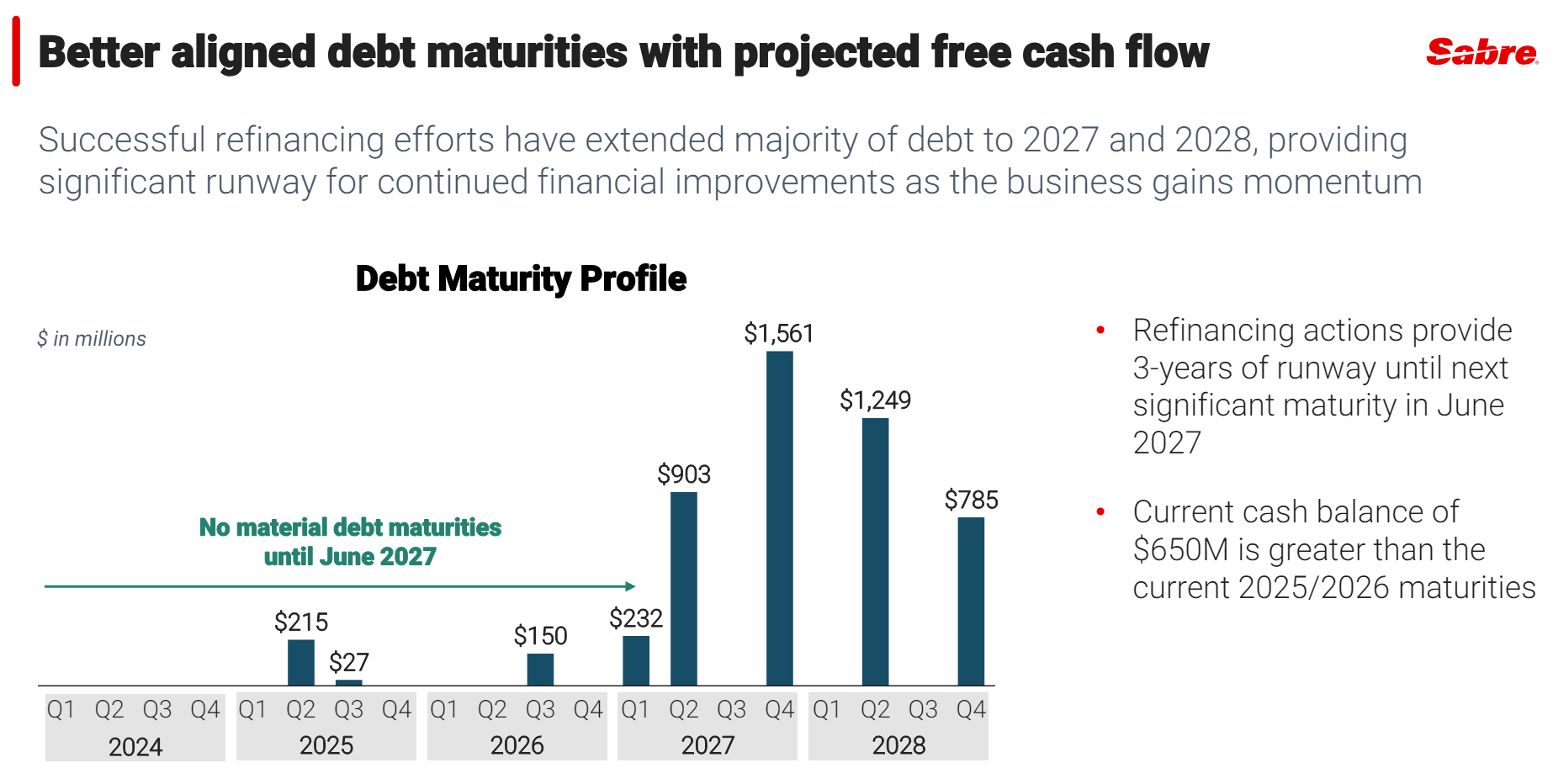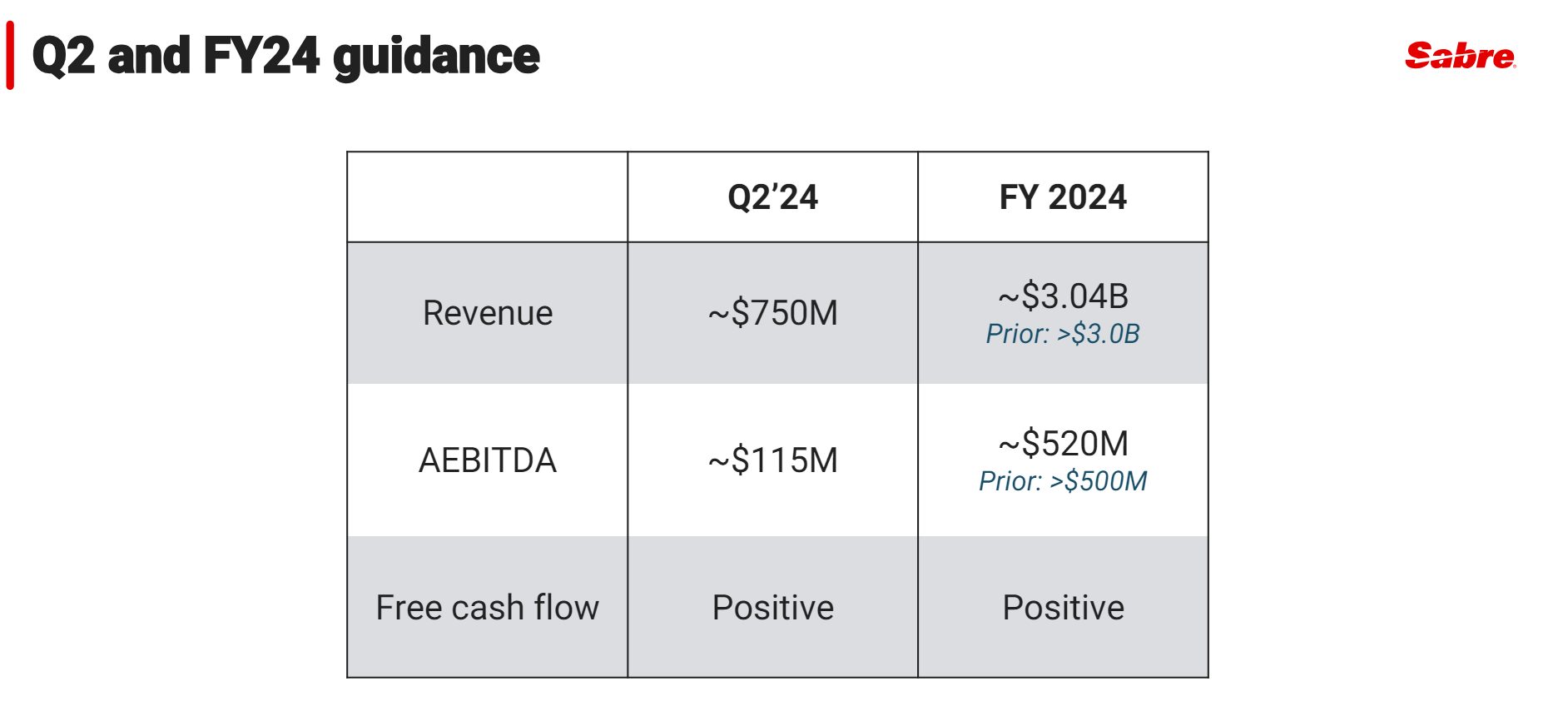

登錄


登錄
海擇短評 Haize Comment:
投資人懷抱著疑慮與不解,迎來Sabre(NASDAQ: SABR)的Q1財報。2月間,隨著Sabre將2025年到期的部分債務挪轉到2027年,然後3月執行總裁Sean Menke突然離職,Sabre市值歷經一個多月的下挫,從16.8億美金最高跌至6.9億美金,跌幅高達59%,並跌破疫情期低點,創下歷史新低。本季Sabre披露的財務結算數據本身不錯,但是真正的風險與挑戰毋寧可說是更加艱鉅。海擇資本分享部分觀點如下:
1. 經理人變動尚非誠信問題:Q1辭去Sabre董事會職位的高管雖然多,但目前看來都並非任職關鍵職位。原董事長兼總裁Sean Menke雖然曾任職CEO,但在將CEO職位交接給Kurt Ekert後,也沒有在季度財報的電話會議出席發言過,看起來不算關鍵職位;而原董事Zane Rowe和Rachel Gonzalez則在離職後,分任Workday的CFO與GE Vernova的總法律顧問,看起來是從董事會的虛職進入實業任職,目前還看不出Sabre在公司治理上發生誠信問題。
2. 本業續好但創新業務不順:Q1公司總收入雖然增加至7.83億美金,YoY成長5%,Adjusted EBITDA達1.42億美金,增長145%,但增長基本來自於航空本業。第二大產品線住宿業務,雖然在EBITDA角度上轉虧為盈,但收入YoY僅增長7%、預訂量YoY僅增長11%,難稱勝任第二大事業的定位;而地面和郵輪產品線的表現甚至還不如住宿;至於公司重點投入的新事業"虛擬卡",YoY的增速也只有31%,以創新業務來看,增長並不算好。
3. 債務問題是首要困擾:本次Sabre將2025年到期的部分債務轉移到2027年,將原有於2025年到期的7.375%與9.250%債務,更改為於2027年到期的8.625%的債務,相當於用"借新還舊"延後了償還本金的時間並增貸了一些本金,這件事本身是中性的,我們計算一年大概會因此增加約7,000萬美元的利息,雖然相對季盈利來說不算低,但也不算致命的問題。主要的風險是,根據公司原本的2025年財測,投資人是基於Sabre能在2025年歸還這筆9.04億美金的本金建立財務模型,現在這筆本金如果延後到2027年才還清本金,雖然公司並不更改EBITDA的預期,但是基於GAAP的財務模型,可得大幅向下重修。
4. 真正的問題在2027:Sabre最大的挑戰是,還債不是朝三暮四、朝四幕三這麼簡單。雖然公司在2024年、2025年、2026年,要償還的本金分別只有0美金、2.42億美金、1.50億美金,但在2027年與2028年,分別要償還26.96億美金與20.34億美金,這對當前一年EBITDA只有5億美金、創新業務看來又沒有戲劇性爆發力的公司來說,明顯資不抵債。沒有人否認Sabre有很好的GDS技術,但龐大債務會壓低併購估值,債務協商又要仰銀行團鼻息,市值要撐住16億美金確實是個挑戰。
-------
Investors, clouded with doubts and confusion, faced Sabre's (NASDAQ: SABR) Q1 earnings report. In February, Sabre shifted some of its debts due in 2025 to 2027, followed by the sudden resignation of CEO Sean Menke in March, leading to a market value plummet from a high of $1.68 billion to $690 million over a month—a 59% drop, falling below the pandemic lows and hitting a historical low. Although Sabre's disclosed financial results for the quarter were decent, the real risks and challenges seem even greater. Here are some perspectives from Haize Capital:
1. The managerial changes at Sabre are not indicative of integrity issues.
2. Core business is strong, but new ventures struggle: In Q1, Sabre's total revenue rose to $783 million, a 5% YoY increase, with Adjusted EBITDA reaching $142 million, a 145% growth, primarily driven by its core aviation business. The second-largest product line, hospitality, turned a profit in terms of EBITDA, but its revenue grew only 7% YoY and bookings increased by 11% YoY, underperforming its position. Ground and cruise lines performed even worse. The company's focus on the new "virtual card" business saw a mere 31% YoY growth, which is lackluster for an innovative business.
3. Debt restructuring is a primary concern: Sabre shifted some of its 2025 debts to 2027, exchanging existing 7.375% and 9.250% obligations due in 2025 for 8.625% debt due in 2027. This "refinancing" essentially postpones principal repayment and slightly increases the principal. This move is neutral, increasing annual interest costs by about $70 million—not negligible but not fatal against quarterly earnings. The key risk lies in the shift of the $904 million principal repayment from 2025 to 2027. Although Sabre's EBITDA forecast remains unchanged, this delay necessitates significant downward revisions to the financial models based on GAAP, previously predicated on 2025 repayment.
4. The real issue arises in 2027: While Sabre has minimal principal repayments in 2024, 2025, and 2026—$0, $242 million, and $150 million, respectively—the figures jump to $2.696 billion in 2027 and $2.034 billion in 2028. Given the current annual EBITDA of only $500 million and lackluster performance in innovative ventures, these obligations significantly outweigh assets. Although Sabre's GDS technology is highly regarded, the massive debt could depress merger valuations. Relying on banks for debt negotiations and maintaining a market value of $1.6 billion will be challenging.


標籤 Label: SABR GDS Debts Amadeus